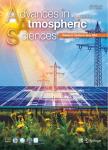The Impact of Assimilating Radar-estimated Rain Rates on Simulation of Precipitation in the 17-18 July 1996 Chicago Floods
The Impact of Assimilating Radar-estimated Rain Rates on Simulation of Precipitation in the 17-18 July 1996 Chicago Floods作者机构:Deptartment of Atmospheric and Oceanic Sciences McGiU University Montreal Canada Recherche en Prevision Numerique Environment Canada Dorval Montreal Canada
出 版 物:《Advances in Atmospheric Sciences》 (大气科学进展(英文版))
年 卷 期:2010年第27卷第2期
页 面:195-210页
核心收录:
学科分类:12[管理学] 1204[管理学-公共管理] 082803[工学-农业生物环境与能源工程] 07[理学] 070601[理学-气象学] 08[工学] 0828[工学-农业工程] 0706[理学-大气科学] 120405[管理学-土地资源管理]
基 金:supported by the Canadian Foundation for Climate and Atmospheric Sciences (CFCAS) and CLUMEQ which is funded in part by NSERC (MRS) FQRNT and Mc Gill University
主 题:quantitative precipitation forecasts 1DVAR data assimilation
摘 要:Rainfall prediction remains one of the most challenging problems in weather forecasting. In order to improve high-resolution quantitative precipitation forecasts (QPF), a new procedure for assimilating rainfall rate derived from radar composite reflectivity has been proposed and tested in a numerical simulation of the Chicago floods of 17–18 July 1996. The methodology is based on the one-dimensional variation scheme (1DVAR) assimilation approach introduced by Fillion and Errico but applied here using the Kain-Fritsch convective parameterization scheme (KF CPS). The novel feature of this work is the continuous assimilation of radar estimated rain rate over a three hour period, rather than a single assimilation at the initial (analysis) time. Most of the characteristics of this precipitation event, including the propagation, regeneration of mesoscale convective systems, the frontal boundary across the Midwest and the evolution of the low-level jet are better captured in the simulation as the radar-estimated precipitation rate is assimilated. The results indicate that precipitation assimilation during the early stage can improve the simulated mesoscale feature of the convection system and shorten the spin-up time significantly. Comparison of precipitation forecasts between the experiments with and without the 1DVAR indicates that the 1DVAR scheme has a positive impact on the QPF up to 36 hours in terms of the bias and bias equalized threat scores.



